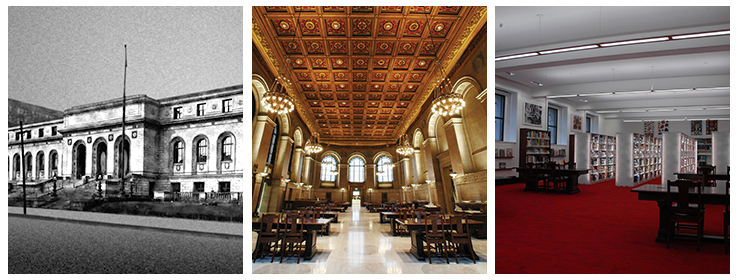St. Louis has a rich architectural heritage, and its Central Library, built in 1912, is one of its most significant landmarks. But a century of wear and tear had taken its toll on the classic structure.
In 2010, the St. Louis Public Library closed its flagship location for two years to embark on a $70 million renovation to preserve and update the original 185,000 square foot building.
Designed by architect Cass Gilbert, the building was laid out with a central Great Hall and five wings. Four required repurposing and technical upgrades, while the fifth – a steel-framed “building within a building” that functioned as a seven-story book storage tower – posed seismic and fire hazards and needed to be replaced entirely.
It's now a brightly lit, multi-story atrium that serves as a new north side entrance. Among the other improvements, a new 244-seat auditorium was carved out of a former sub-basement space once occupied by a coal bin. In all, 38,450 square feet of public space was gained, and the project won the Architizer A+ award for best library, a com- petition with more than 150,000 public votes worldwide.
A massive coatings job
BSI Constructors, the general contractor on the job, hired The Paintsmiths of St. Louis for the coatings planning and application.
"The library project required a team of talented, well-managed, committed and versatile crafts- people, and Paintsmiths was the consummate team player," says Paul Goelz, BSI project manager. "They excelled in all aspects of the execution of the painting, adroitly managing the lengthy and tedious submittal process and color selections/confirmations. They overcame the numerous challenges that arose during the restoration of the original Cass Gilbert-designed finishes, including the restoration of several ornate ceilings and the restoration and refinishing of wood wainscot, shelving, tables and doorframes. Simultaneous to dealing with the challenges of the historic restoration, Paintsmiths met the schedule challenges during the execution of the other areas within the building and provided exceptional quality throughout."
Ability to solve problems
Prepping some of the 100-year- old surfaces was another test that required the problem-solving skills of an experienced firm like Paintsmiths.
“In one room, we tried chemical strippers and a number of other methods to remove paint from the window trim,” says Jamie Callaway, Paintsmiths project manager. “We had to be extremely careful to make sure that the wood underneath was not damaged. At first, nothing was working. Finally we came up with the idea of spraying the area with dry baking soda. It was very time-intensive – we had to do it one square inch at a time.”
All the work was handled in-house and showed the capabilities of the employees of a firm that performs commercial, light industrial and residential work.
"We are constantly growing and reaching out to new cleaning methods and new products and new application methods," Callaway says.
"The guys on our staff really stepped up on every aspect of this job. They were excited to have the challenge."
Taking care of color
Color was a challenge of its own. Exact matches were necessary in a number of areas. Many were from the Sherwin-Williams color palette, while others were custom matched to historically accurate shades or mixed on site.
Paintsmiths used ProMar 200 Zero VOC Interior Latex Paint on walls throughout the project, even for dark colors such as Burgundy (SW 6300).
"ProMar 200 Zero VOC in the deep bases and ultra deep performed even better than expected," Callaway says. "Coverage was not an issue."
ProMar 200 Interior Latex Flat was used on ceilings, and crews also made use of specialty products like Acrolon 218 polyurethane, Macropoxy 646 epoxy, and Sher-Cryl HPA where higher performance coatings were needed.
"Sher-Cryl is our go-to metal door finish when we need a high performance acrylic coating that will stand up to everyday abuse," Callaway says.
The library project was also the first time Paintsmiths used the Sherwin-Williams custodian service to track colors.
"At the end of the project Sherwin-Williams was able to print us a complete list of all of the colors we used and their locations," he says. "This, along with a color formula and a dot card, was given to the owner to provide them with a permanent record of the colors and their locations throughout the building so that 100 years from now the next crew will know what to do when they restore this wonderful building again."
In the end, all the hard work over two years was well worth it for the hometown painting company.
"This was a once-in-a-lifetime job in St. Louis," Callaway says. "It won't be painted again in my lifetime, and it was great to be part of it."







